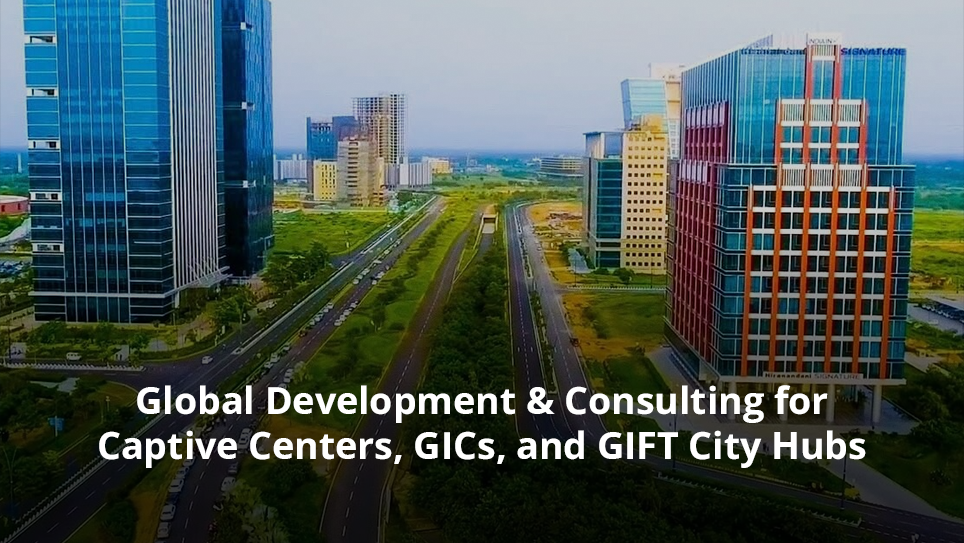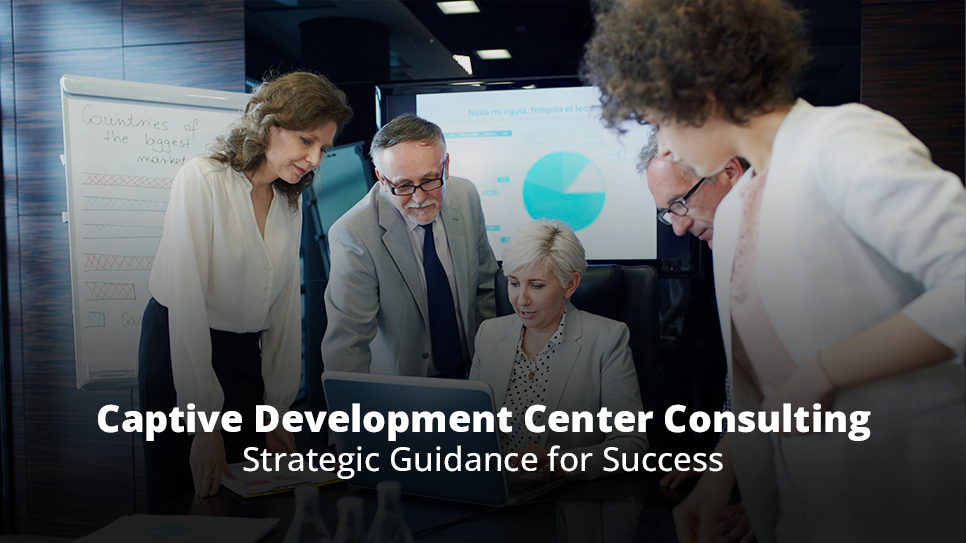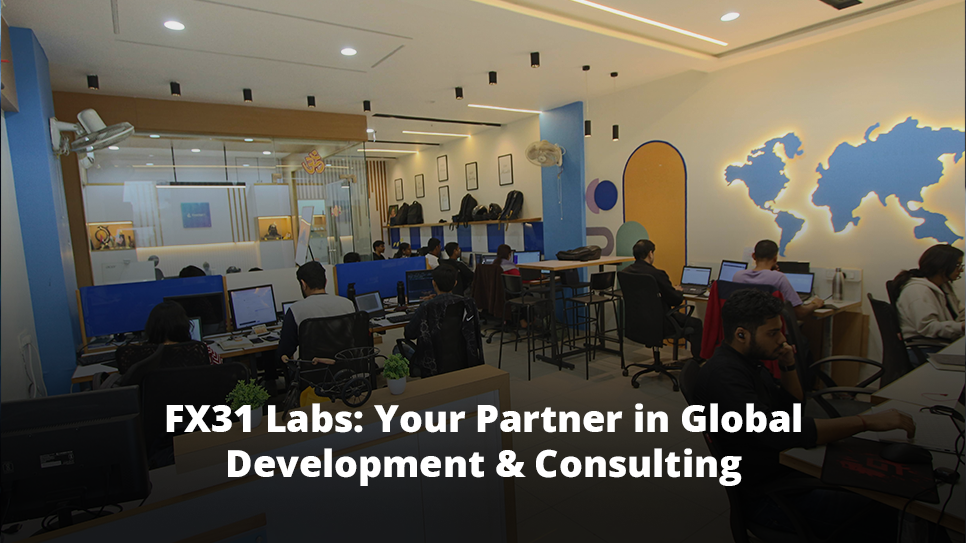Global Development & Consulting for Captive Centers, GICs, and GIFT City Hubs

Imagine a fast-growing enterprise planning to expand its global development capabilities. The CTO faces a pivotal decision: outsource projects to third parties, or build a dedicated in-house team overseas?
In scenarios like this, Global Development & Consulting expertise becomes critical. Establishing a captive center – often known as a Global In-House Center (GIC) – can unlock vast talent pools and drive innovation abroad, but it also means navigating unfamiliar terrain in logistics, regulations, and culture.
From India’s established tech cities to emerging hubs like the GIFT City Software Development Hub, companies are exploring new destinations for global expansion. This blog delves into how Global Development & Consulting services support CTOs, enterprise tech leaders, and product heads in setting up successful captive centers and GICs. We’ll highlight key considerations, benefits, and the role of specialized partners (such as FX31 Labs) in guiding global in-house center initiatives.
The Rise of Captive Centers and GICs
In the last few decades, many multinational companies have embraced captive centers (also called GICs or Global Capability Centers) as a strategic alternative to outsourcing. But what exactly is a GIC or captive center?
In simple terms, it is an internal offshore unit of a company that handles specific functions (e.g., software development, R&D, back-office operations) and is fully owned by the company. Unlike outsourcing to a vendor, the work remains in-house, just executed in a global location.
However, the role of GICs has evolved dramatically over time. No longer mere cost-saving satellites, today’s captive centers have transformed into innovation and excellence hubs that drive strategic value. Modern GICs work on complex, high-value projects – from product development and advanced R&D to AI and digital initiatives – rather than just routine processes.
For instance, JPMorgan’s large GIC in India supports technology and operations globally, enabling efficient workflows and innovations within the bank’s services. Similarly, General Electric’s captive center in Bangalore focuses on R&D and software development, aligning local expertise with GE’s global strategy.
Why Build a Captive Center? (Captive vs Outsourcing)
Launching a captive center or GIC is a major initiative, so why do tech leaders pursue this model instead of outsourcing to third-party vendors? The motivations often include:
- Greater Control and Consistency: A captive center is an extension of your company, run by your teams. This means you set the quality standards, security protocols, and work culture, ensuring consistency with headquarters.
- Access to Specialized Talent & Innovation: By establishing a presence in global talent hotspots, firms gain direct access to skilled engineers and domain experts. A well-run GIC can become an innovation hub where new product ideas and R&D flourish, leveraging local expertise.
- Cost Efficiency with Value: Cost savings are still a key driver. Locations like India offer significant operational cost advantages – from salaries to infrastructure – without compromising quality.
- Alignment and IP Security: Unlike outsourcing, an in-house global center means your IP stays within the company. Sensitive projects can be handled internally. Also, the team in a GIC works exclusively for the parent organization, aligning closely with its mission and product vision.
Of course, outsourcing has its place for flexibility or short-term needs. But for CTOs and product heads planning core long-term development, a captive center offers strategic advantages that outsourcing may not match.
Global In-House Center Setup Services: Laying the Groundwork
Once the decision is made to build a captive center, the next challenge is execution. Setting up a GIC in a new country involves myriad moving parts, and this is where Global In-House Center Setup Services come into play. These services, often provided by specialized consulting firms, guide companies through the end-to-end process of establishing a successful offshore development hub.
What does setting up a GIC entail? Key steps and considerations include:
- Strategic Planning & Objectives: First, clarify the purpose and scope of the GIC. Is the goal to tap into specific tech talent (e.g., AI experts), accelerate product development, or provide 24/7 support? Defining clear objectives will shape all other decisions.
- Location & Infrastructure: Choosing the right city (or hub) is critical. Factors like talent availability, cost of living, connectivity, and government incentives will influence location selection.
- Regulatory Compliance & Entity Setup: Navigating local laws is a major task. Companies must set up a legal entity, register with government bodies, and comply with tax, labor, and export regulations.
- Talent Acquisition & HR Setup: Hiring the right people will make or break the GIC. This involves not just recruiting skilled engineers and managers, but also establishing HR policies, benefits, and a work culture that aligns with the parent company.
- Operational Processes & Integration: To truly function as an extension of HQ, the captive center needs well-defined processes. This includes communication workflows (e.g., agile methodologies across time zones), security and IP protection measures, and integration of tools and platforms with the home office.
Bringing all these pieces together is no trivial task. It requires local insight, project management, and cross-functional coordination. That’s why enterprises often partner with firms offering Global In-House Center Setup Services to accelerate the launch of their GIC. \
Also read: Why Selecting the Right Technological Partner Is Critical to a Startup’s Success
Captive Development Center Consulting: Strategic Guidance for Success

Launching the center is only the beginning – the real value comes from how it is managed and scaled over time. Captive Development Center Consulting refers to the ongoing strategic and operational advisory services that help a company maximize the performance of its captive center. Enterprise tech leaders often engage such consulting to continually refine their GIC’s strategy as business needs evolve.
Key areas where captive development center consulting adds value include:
- Operating Model & Governance: Consultants help define how the GIC will operate. This covers the org structure, leadership roles, and governance processes between the onshore (headquarters) and offshore teams.
- Performance Optimization: It’s important to regularly assess whether the captive center is meeting its goals (cost savings, innovation output, faster time-to-market, etc.). Consultants analyze performance metrics and benchmark them against industry standards or initial business cases.
- Scaling and Capability Expansion: As the GIC matures, companies often want to scale up operations or add new capabilities (for instance, expanding from software development into data science or UX design).
- Compliance and Risk Management: Especially for companies in regulated industries (finance, healthcare, etc.), ensuring the captive center complies with all relevant regulations is critical. Consulting teams conduct periodic compliance audits and risk assessments.
In short, Captive Development Center Consulting is about continuous improvement and strategic evolution. It ensures the captive center doesn’t stagnate or veer off course after setup.
GIFT City Software Development Hub: India’s Emerging Tech Oasis
- GIFT City (Gujarat International Finance Tec-City) is India’s first International Financial Services Centre (IFSC), located in Gujarat.
- It is a planned business city developed to serve as a world-class hub for financial and IT services.
- Unlike typical tech parks, GIFT City operates under a special economic zone with its regulatory framework, designed to attract international business.
- The city offers modern infrastructure, tax incentives, and regulatory ease, making it an attractive destination for captive centers and Global In-House Centers (GICs).
Recent Highlights:
- Infineon Technologies, a German semiconductor company, has announced a new Global Capability Centre (GCC) in GIFT City.
- The center will focus on R&D for chip design, software development, and IT solutions.
- It’s expected to create around 400 engineering jobs, strengthening Infineon’s global R&D capabilities.
- Infosys and Wipro, two of India’s largest IT firms, are also setting up fintech-focused development hubs in GIFT City.
- As of late 2024, approximately 60 fintech entities are already registered and operational in the GIFT IFSC, indicating a growing and active ecosystem.
FX31 Labs: Your Partner in Global Development & Consulting

- FX31 Labs specializes in Global Development & Consulting, helping tech companies establish and grow captive centers and innovation hubs.
- They offer comprehensive Global In-House Center Setup Services – covering everything from market research and location strategy to legal setup and talent acquisition – ensuring faster go-live with minimal friction.
- Through ongoing Captive Development Center Consulting, FX31 Labs supports performance benchmarking, process improvement, and scaling roadmaps to turn GICs into high-value innovation engines.
- The firm is also actively aligned with emerging hubs like the GIFT City Software Development Hub, offering clients localized expertise and execution support for high-potential global expansions.
Conclusion: Driving Global Growth with the Right Partners
For CTOs and enterprise leaders, establishing a captive center or GIC is not just an operational move but a strategic milestone in global growth. When done right, a global in-house center can accelerate innovation, optimize costs, and secure a competitive edge by harnessing talent worldwide.
This is where Global Development & Consulting capabilities prove invaluable. Leveraging experts who have done it before allows companies to avoid pitfalls and hit the ground running. Whether it’s tapping into Global In-House Center Setup Services to lay a solid foundation or utilizing ongoing captive development center consulting for continuous improvement, the right support can turn a daunting project into a well-orchestrated success story.
FX31 Labs and similar firms provide that guiding hand, aligning your vision with local expertise and execution prowess. By blending your company’s ambition with Global Development & Consulting experience, you can confidently build captive centers that become engines of growth and innovation.
Ready to Build Your Global Engineering Hub?
FX31 Labs brings the insight, strategy, and on-ground execution needed to set up and scale captive centers that deliver long-term value.
Whether you’re exploring a GIC in GIFT City or expanding development operations abroad, our team can help you move faster, smarter, and with confidence.
Connect with FX31 Labs to start your global development journey today.
